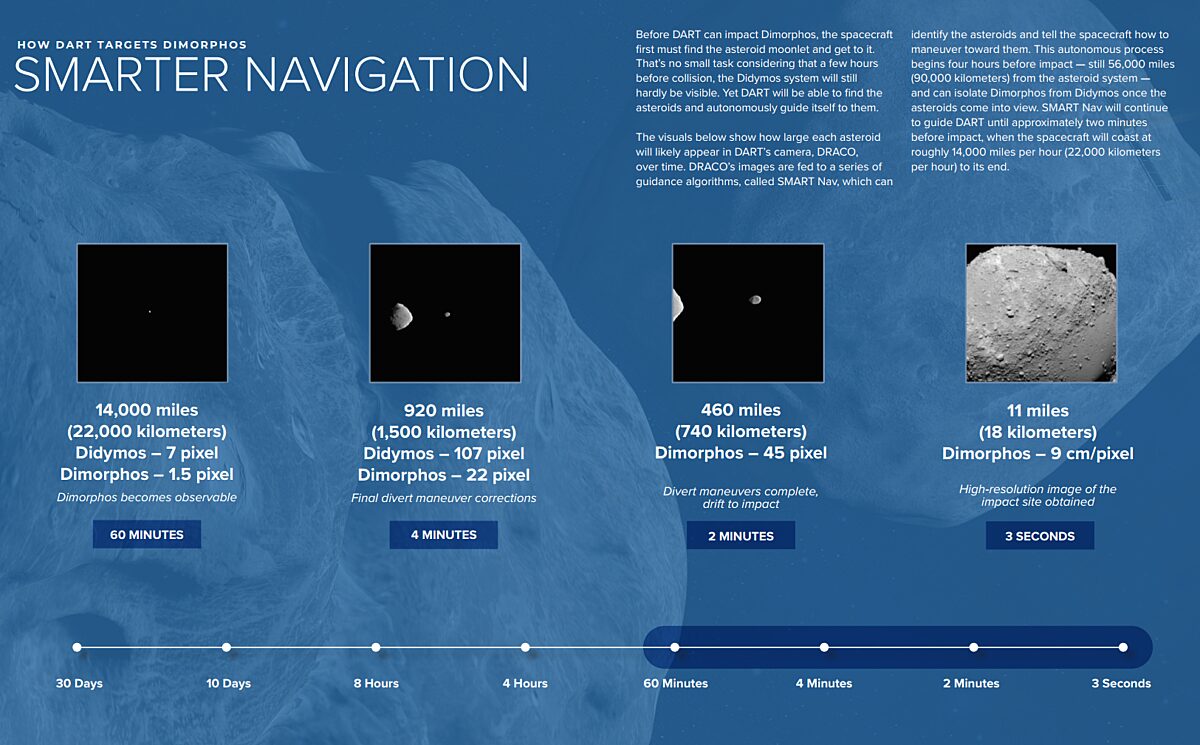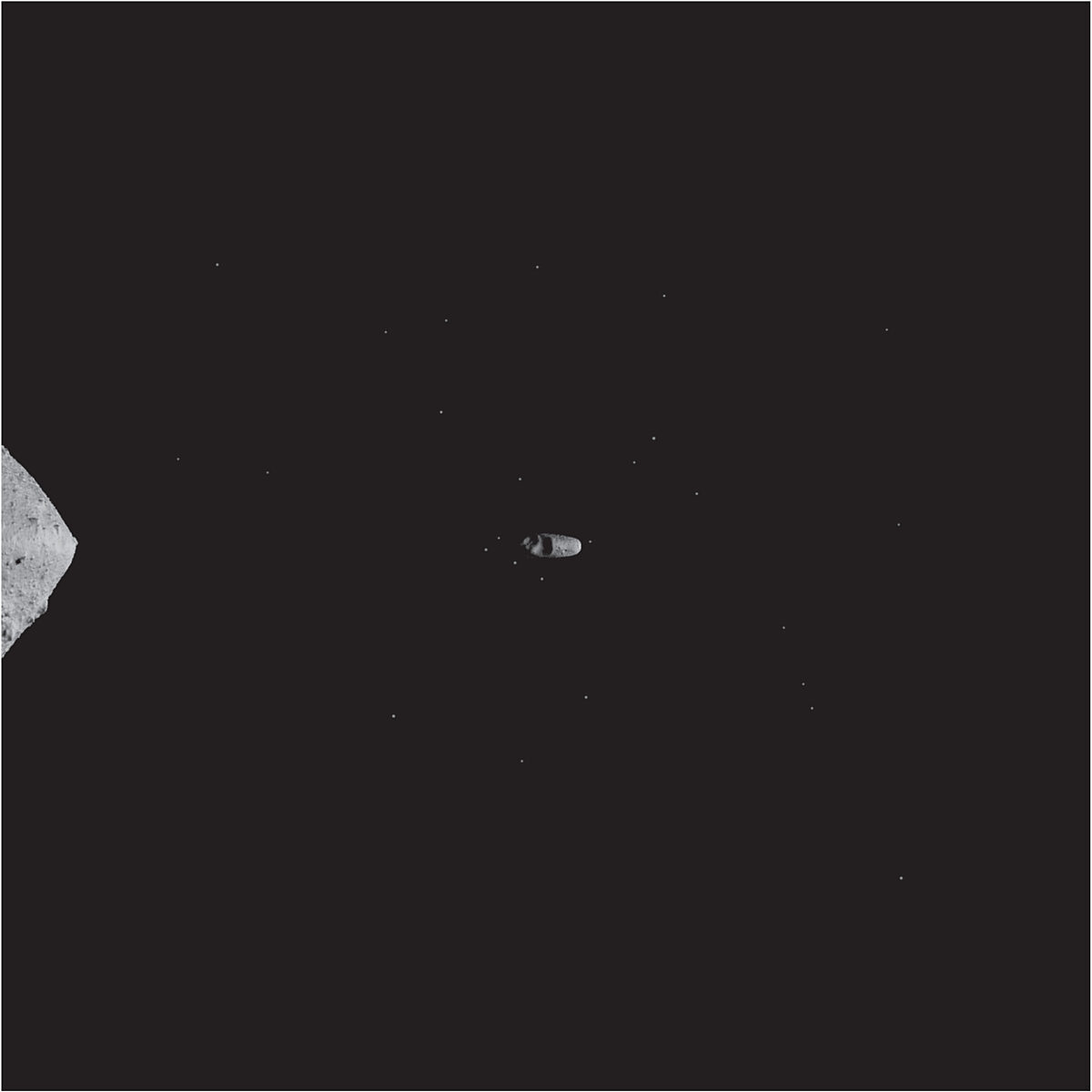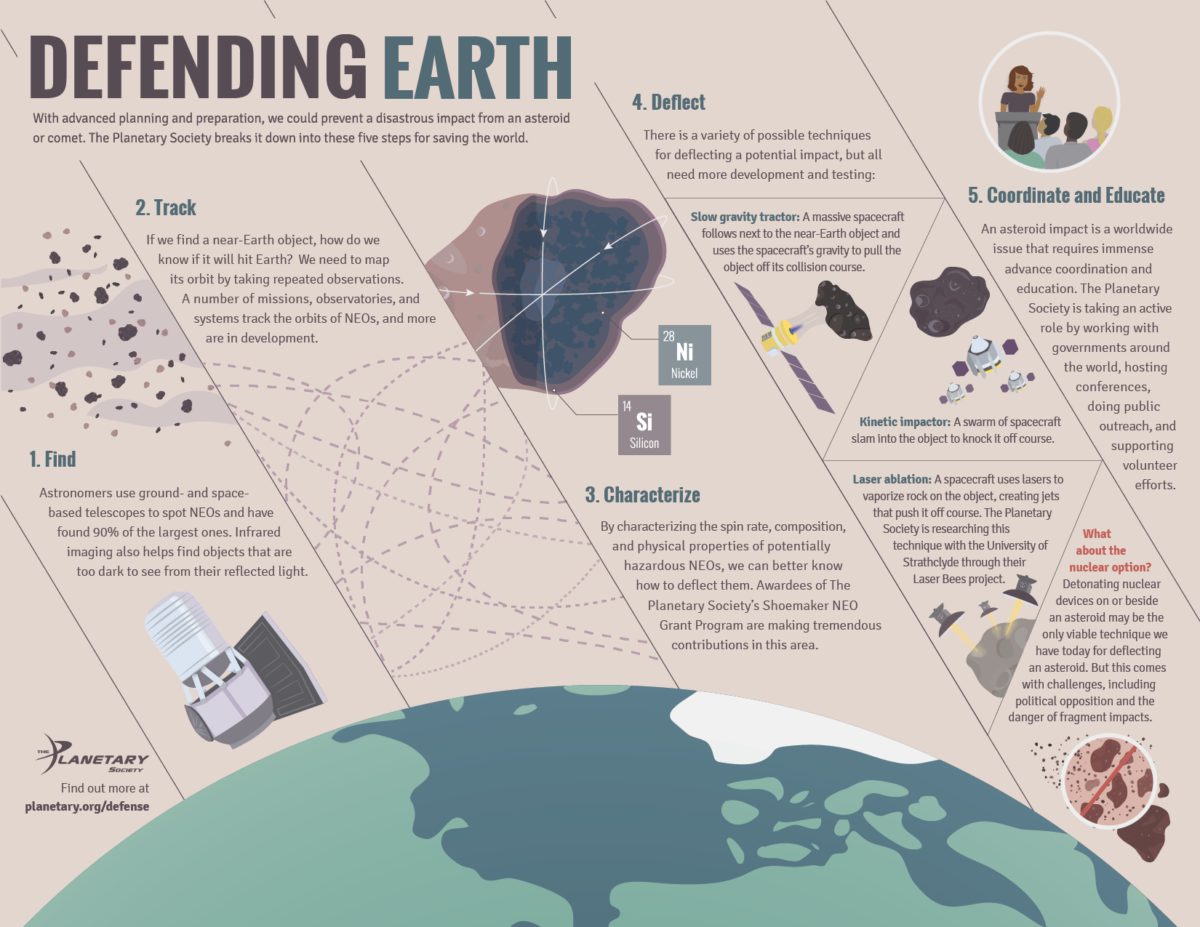Jason Davis • Sep 21, 2022
DART impact: What to expect
Update: on Sept. 26, 2022, DART impacted the asteroid moon Dimorphos, completing its mission. You can see some of DART's final images from the impact here.
NASA is preparing to intentionally smash a spacecraft into an asteroid, demonstrating a technique for deflecting dangerous space rocks on course to hit Earth.
On Sept. 26, DART, the Double Asteroid Redirection Test, will plow into the asteroid moon Dimorphos at 7:14 p.m. EDT (23:14 UTC). Live coverage on NASA TV begins at 6:00 p.m. EDT. During the mission’s final hour, DART will be sending home images once every second as Dimorphos grows from a point of light to an object that fills the entire camera frame.
DART’s impact will alter Dimorphos’ orbit around its larger parent asteroid, Didymos. Earth-based telescopes will be able to see this change, verifying the test was successful. A CubeSat deployed by DART will also observe the impact, while the European Space Agency’s Hera probe will visit Dimorphos in 2026 to study the crater DART made.
Asteroids have been hitting Earth for billions of years. Starting with DART, humanity is finally hitting back.

Why is DART important?
About 66 million years ago, an object 10 kilometers (6 miles) wide struck the Earth, causing mass extinctions and killing the dinosaurs. We think we’ve found most asteroids this size (although some still elude detection), and none are on course to hit Earth.
However, it doesn’t take an object that large to cause devastation. Under the right conditions, an asteroid just 50 meters (160 feet) wide can cause mass casualties. In 2013, a small asteroid roughly 20 meters wide exploded near Chelyabinsk, Russia, injuring 1,500 people and damaging 7,200 buildings across six cities.
Asteroids with orbits that bring them close to Earth are called near-Earth asteroids, or near-Earth objects (NEOs). If we find a hazardous NEO on course to hit Earth with enough time to spare, we may be able to knock it off course with a small nudge. This is known as the kinetic impactor technique. DART will test this technique by slamming into asteroid Dimorphos, proving that a spacecraft can alter an asteroid’s orbit.
When will DART impact Dimorphos?
DART will impact Dimorphos on Sept. 26, 2022 at 7:14 p.m. EDT (23:14 UTC). Live coverage on NASA TV begins at 6:00 p.m. The mission is managed by the Johns Hopkins Applied Physics Laboratory in Baltimore, Maryland.
Traveling at the speed of light, it will take DART’s final transmissions 38 seconds to reach Earth. The impact will mark the culmination of a 10-month journey for the spacecraft, which launched on Nov. 21, 2021.
What can we expect to see in DART’s final moments?
We won’t see much until the final hour — and especially the last five minutes.
DART can already see Didymos and Dimorphos, but they are still just a single point of light. Didymos and Dimorphos are relatively small, and DART is moving fast. While recent asteroid missions like Hayabusa2 at Ryugu and OSIRIS-REx at Bennu have featured leisurely approaches and lots of pretty pictures, DART will close in on Dimorphos at a blistering speed of 6.6 kilometers (4 miles) per second.
Didymos measures about 780 meters (2,560 feet) across, placing its size between Ryugu and Bennu. Dimorphos is smaller than both, measuring just 160 meters (525 feet) across.
Four hours before impact, the spacecraft’s single telescopic camera, DRACO, will start feeding images to a series of navigation algorithms called SMART Nav. It’s SMART Nav’s job to find Dimorphos and autonomously steer the spacecraft towards impact.
Those images will stream to Earth at a rate of about one per second. Although DRACO’s detector measures 2560 x 2160 pixels, the images are processed and compressed to just 512 x 512 pixels so DART can send them at a rapid pace.
NASA TV will receive these images at the same time as the DART team. Here’s what we can expect to see:
One hour to impact: DART should finally be able to see Dimorphos as a separate point of light, though it will still only be a pixel or two across.
Four minutes before impact: Both asteroids should still be in the camera frame. Didymos will measure about 100 pixels across, while Dimorphos will measure about 20 pixels across.
Two minutes before impact: It will be clear that DART is bearing down on Dimorphos, which will measure roughly 45 pixels across.
Twenty seconds before impact: DART will be able to see rocks and boulders on Dimorphos the size of vending machines, said Terik Daly, the DRACO deputy instrument scientist. “If everything goes according to plan, then the final seconds before impact will allow us to see details on the surface with a pixel scale of about ten centimeters (about 4 inches) per pixel,” Daly told The Planetary Society.

And then it will all be over. DART will plow into Dimorphos, vaporizing the spacecraft. The resulting crater could be up to about 20 meters wide (66 feet) wide, but that ultimately depends on the composition of Dimorphos. By the time we see DART’s transmissions end, the spacecraft will have already been gone for 38 seconds — the time it takes for signals traveling at the speed of light to reach Earth.
How will we know DART succeeded?
It will ultimately take observations from ground-based telescopes to determine whether DART succeeded.
From Earth, Didymos and Dimorphos look like a single point of light from Earth. That point of light fluctuates as the two asteroids pass in front of one another. This allows astronomers to measure Dimorphos’ orbit around Didymos.
DART’s impact should lower the time it takes Dimorphos to circle Didymos from roughly 11.9 hours to 11.8 hours, proving that the kinetic impactor technique is capable of shifting an asteroid’s orbit.
The DART team relies on dozens of telescopes around the world for their observations, including the Lowell Discovery Telescope in Arizona, the Las Campanas Observatory in Chile, the Las Cumbres Observatory global network, and the Magdalena Ridge Observatory in New Mexico.
What will DART’s CubeSat do?
Roughly 10 days before impact, DART will deploy a CubeSat named LICIACube, the Light Italian Cubesat for Imaging of Asteroids.
Built by the Italian Space Agency, LICIACube’s goal is to observe DART’s impact, the plume it generates, and possibly the resulting crater. It will do so from a distance of about 50 kilometers (31 miles) using two cameras named LUKE and LEIA.
Don’t expect images from LICIACube right away: The CubeSat can only communicate with Earth using slow data rates, so it could take months for all of its data to get sent home to scientists.

How will Hera investigate DART’s impact?
To study in detail what happened when DART smashed into Dimorphos, the European Space Agency will launch a mission called Hera in 2024. Hera will arrive in 2026 carrying a suite of instruments to study both Didymos and Dimorphos, and especially the impact crater that DART made. The spacecraft has a laser altimeter that will create 3D maps, and an infrared camera that will take the asteroids’ temperatures and investigate their surface properties.
Hera will also deploy two of its own CubeSats. They will study the asteroids’ interiors before attempting to land on Didymos, Dimorphos, or both asteroids.
How is DART different from Deep Impact?
Deep Impact was not a planetary defense mission. Launched in January 2005, the spacecraft fired an impactor into Comet Tempel 1 on July 4, 2005. The impact revealed the comet was about 75% empty space and probably came from the Oort cloud, a shell of icy objects that surrounds our solar system.
After finishing its mission at Tempel 1, Deep Impact was renamed to Deep Impact (EPOXI) and sent to Comet Hartley 2. EPOXI is a double-nested acronym that stands for Extrasolar Planet Observations (EPOCh) and Deep Impact Extended Investigation (DIXI).
NASA intended to send Deep Impact (EPOXI) to visit a third comet after Hartley 2, but communication was lost with the probe in August 2013.

How much does DART cost?
The DART mission costs $324.5 million. NASA’s planetary defense program spent $308 million on the spacecraft itself, $68.8 million for launch services, and $16.5 million on operations and data analysis.
How else can we prevent asteroid impacts?
DART is just one piece of a much larger puzzle that must be solved to keep dangerous asteroids from impacting the Earth.
First, we have to find near-Earth objects. The upcoming NEO Surveyor mission will greatly improve the percentage of asteroids we’ve detected.
Once we find an asteroid, we have to track and characterize it. The world’s professional sky surveys cannot handle all of this work on their own, which is why The Planetary Society funds asteroid-hunting astronomers through our Shoemaker NEO Grants.
By finding, tracking, and characterizing asteroids, and then testing deflection techniques, we can greatly reduce the chances that our planet will be struck by a dangerous space rock.

Support our core enterprises
Your support powers our mission to explore worlds, find life, and defend Earth. You make all the difference when you make a gift. Give today!
Donate

 Explore Worlds
Explore Worlds Find Life
Find Life Defend Earth
Defend Earth

